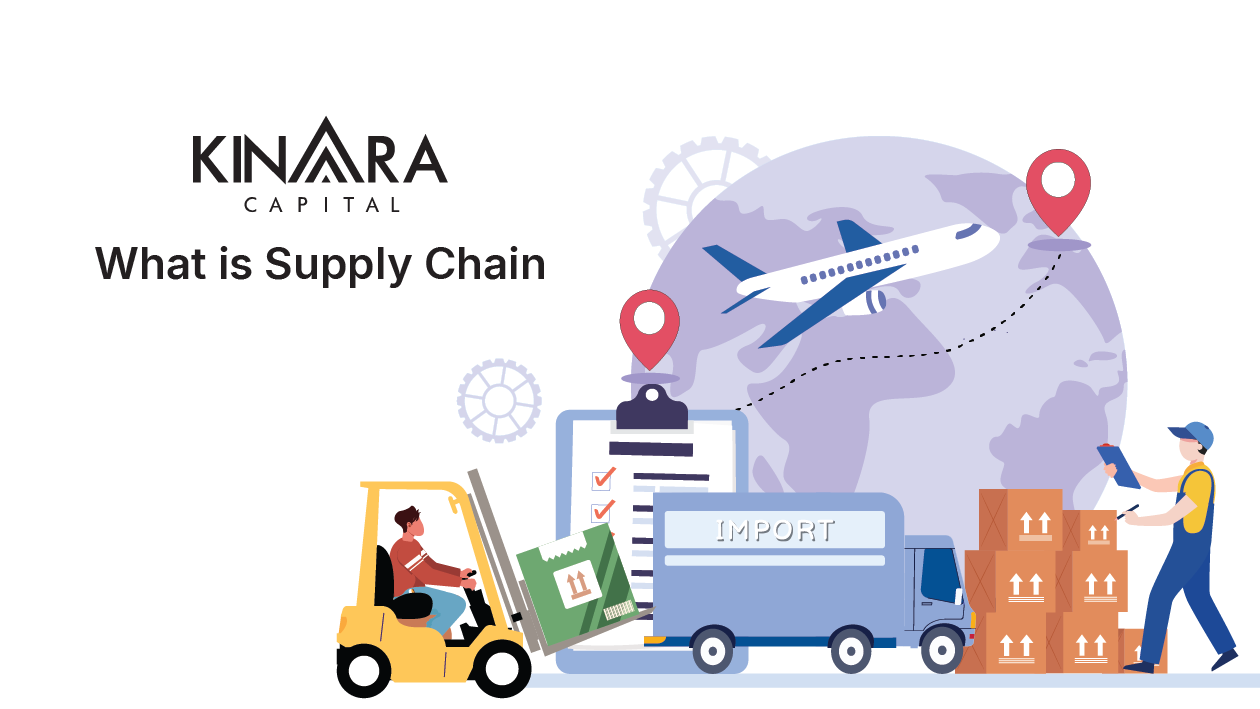
The supply chain distribution process is how businesses move their products and services from suppliers to customers. Distribution plans are heavily influenced by the company’s business objectives.
Now, what is the supply chain? There are numerous definitions of supply chain distribution, some of which overlap with one another. One common definition of distribution is the process of making goods available to consumers or other user businesses by moving them from the manufacturer or distributor as needed. Other broader definitions consider it a method of transferring goods from supplier to manufacturer to wholesaler or retailer to the end consumer or user.
Now that you know what a supply chain is, you also need to know why it’s given so much importance. An efficient, optimized supply chain is critical to a company’s ability to fulfill its customers’ orders. If you manage the supply chain well, it can result in significantly lower costs and a shorter production cycle. When it comes to supply chain operations, supply chain management (SCM) is an umbrella term that covers product development, sourcing, production, procurement, logistics, and more. Without effective SCM, businesses risk losing customers and losing a competitive edge in their respective industries.
However, SCM is about more than just creating the most efficient process; it’s also about mitigating risks and ensuring everything runs smoothly. This is due to the fact that the supply chain consists of numerous components, ranging from manufacturing sites and warehouses to transportation, inventory management, and order fulfilment.
Each step in this process carries a plethora of risks and possibilities that can derail an entire order. Minimizing delays, optimizing the time of day that goods are moved, the length of time inventory is held, and the order dispatch process are all factors that can have a significant impact on the operation. Without an optimized supply chain management process in place, the chain may fail at any point.
It can be difficult to achieve success as a business owner in a rapidly expanding global market. An optimized, end-to-end connected supply chain can propel your company forward in the competitive ecosystem. So, after knowing all about what is supply chain, you also need to find out what the best practices are to streamline the process:
Real-time, connected supply chain planning can help ensure your company isn’t planning based only on historical data. When using historical data, it can be very difficult to overcome any unforeseen circumstances that cause disruptions. When real-time planning is in place, scenarios can be handled much more efficiently.
Supplier relationships are critical to the success of your supply chain. These connections necessitate ongoing upkeep and two-way communication between the buyer and seller. To ensure continued success of your relationships, you should have a specific, optimized platform in place for conflict resolution.
A supply chain council can assist you with this. If the SCM strategy is not aligned with the company’s strategies, it will not perform to its full potential. A coordinated, efficient supply chain strategy that is aligned with the organization’s overall operations can reduce operational costs, improve supply chain quality, and reduce errors while streamlining procurement.
Today the distribution chain is experiencing unprecedented disruptions, presenting both challenges and opportunities for all parties involved in the supply and distribution system. MSMEs face an even greater challenge as these changes necessitate rapid initiatives to embrace digital and business transformations. The entry of new players into their segment, particularly large enterprises with deep pockets, poses a threat to MSMEs.
MSMEs face challenges like limited resources, inefficient processes, and poor visibility in supply chain management. To overcome these, MSMEs can adopt digital tools for better efficiency and transparency. Building strong relationships with suppliers and customers enhances collaboration, while employee training improves supply chain handling. Implementing inventory management systems optimises stock levels, and sustainable practices reduce costs. Government schemes and financial assistance for MSMEs provide crucial support, helping these enterprises effectively navigate supply chain challenges.
Thus, the current environment compels MSMEs to reconsider the physical logistics of moving inventory along a distribution chain, how goods are moved, where inventory is stored, and how to identify your customers and their needs to keep them loyal to you. Businesses, particularly MSMEs, must take a more professional approach to operations management in order to survive and grow!
Mapping out a supply chain is an essential step in strategic planning and external analysis. Clearly defining the supply chain helps a company understand its market and plan its future direction. This comprehension is crucial for developing corporate-level strategies, enabling the company to decide whether to focus on a single line of business or diversify into related or unrelated industries.
Supply chain management involves overseeing each stage of the supply chain, encompassing various industries such as raw material extraction and manufacturing. By thoroughly understanding the supply chain, a company gains insights into the stakeholders involved at each stage. This knowledge provides valuable perspectives on the attractiveness and competitiveness of potential industries for future expansion. Effective supply chain management ensures that a company can make informed decisions, optimise operations, and maintain a competitive edge in the market. Ultimately, a well-mapped supply chain supports strategic decision-making, enhances efficiency, and promotes sustainable growth.
The choice of a supply chain model depends on a company’s structure and specific operational needs. Here’s a breakdown of the main supply chain management models:
This model is ideal for companies with stable production processes and consistent product demand. It is suitable for those manufacturing uniform products with minimal variation. In this model, products are produced on a continuous basis, allowing for streamlined operations and strict inventory control. Managers need to ensure a regular supply of raw materials to avoid production disruptions and maintain efficiency.
This model is tailored for businesses that operate in dynamic markets, such as fashion and technology, where speed is crucial. Companies using the fast chain model need to rapidly transition from concept to market, responding quickly to emerging trends. The goal is to accelerate the development cycle, from idea generation to prototype, production, and distribution, to capitalize on fleeting opportunities and trends.
Often employed by companies dealing with seasonal or holiday products, the flexible model is designed to handle fluctuating demand patterns. This model allows businesses to scale production up or down based on market demand. Companies must be adept at forecasting to manage raw materials, inventory, and labour efficiently. The flexibility ensures that they can quickly ramp up production during peak times and scale down when demand subsides, optimizing both resources and profitability.
Understanding these supply chain management models helps companies choose the best strategy to align with their production and market demands, ultimately enhancing efficiency and responsiveness in their supply chain operations.
These are the steps that form the core of the supply chain management process:
Thus, these supply chain management steps show how they help to optimise efficiency and effectiveness across the entire process.
Understanding and optimising the supply chain is vital for businesses to enhance efficiency and gain a competitive edge. The supply chain encompasses the movement of goods from suppliers to customers, impacting all facets of a company’s operations. Effective supply chain management ensures smooth transitions through planning, sourcing, manufacturing, delivery, and returns. By selecting the appropriate supply chain models, businesses can address their specific needs and adapt to market demands.
For MSMEs, overcoming challenges in supply chain management through digital tools and strong supplier relationships can drive growth and improve resilience. Ultimately, a well-structured and managed supply chain supports strategic decisions, operational excellence, and sustainable development, making it a critical component of business success.
Kinara Capital is an RBI-registered fintech NBFC that has already helped 79,000+ MSME entrepreneurs by providing easy access to collateral-free business loans.
Enrolled MSME Business owners can swiftly assess their loan eligibility in just 1 minute by commencing the digital-first application procedure on the Kinara Capital website or by downloading the myKinara App. Eligible MSME entrepreneurs can furnish the requisite documents, and the loan funds will be digitally disbursed to their bank account within 24 hours.
We have a dedicated customer support team available between Monday – Friday (9.30AM – 6.00PM) at our toll free number 1800-103-2683 for any questions or assistance. This ensures that entrepreneurs can get the help they need throughout the loan process.
The key components of a supply chain include suppliers, manufacturers, warehouses, distribution centres, and retailers, all of which work together to deliver products to customers.
Technology improves supply chain management by enhancing visibility, optimizing inventory levels, reducing costs, and improving efficiency through automation and data analytics.
A supply chain focuses on the flow of goods and services from supplier to customer, while a value chain emphasises creating value at each step from product development to after-sales service.
They can do so by diversifying suppliers, investing in technology, maintaining safety stock, and implementing robust risk management strategies.
These include digitalisation, artificial intelligence, blockchain technology, sustainability initiatives, and increased use of data analytics.
Sustainability in supply chain management focuses on reducing environmental impact, promoting ethical practices, and improving social responsibility throughout the supply chain.
The objectives of supply chain management (SCM) include reducing costs, improving efficiency, ensuring timely delivery, enhancing customer satisfaction, and maintaining high-quality standards.
